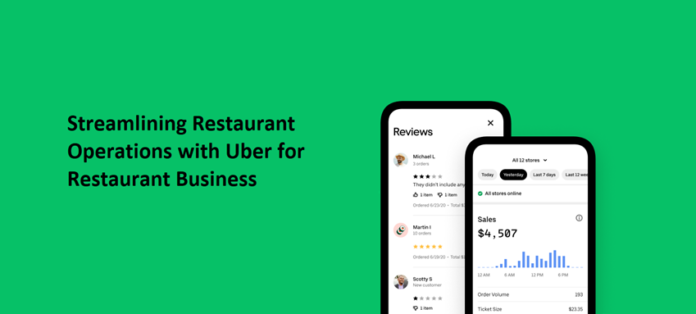In the competitive landscape of the restaurant industry, operational efficiency plays a crucial role in driving success. Every aspect of restaurant operations must be streamlined, from order management to delivery logistics, to ensure customer satisfaction and profitability. Uber for Restaurant Business is one solution that has revolutionized how restaurants operate. By leveraging the power of the Uber platform, restaurants can enhance their operations and reap many benefits.
Understanding Uber for Restaurant Business
Uber for Restaurant Business is a concept that allows restaurants to utilize the Uber network and infrastructure to streamline their delivery operations. By partnering with Uber, restaurants access a vast pool of delivery drivers and a robust delivery management system. This partnership offers several advantages that can significantly benefit restaurant businesses.
Benefits of Using Uber for Restaurant Business
Improved Delivery Logistics and Efficiency
Uber for Restaurant Business provides a sophisticated delivery management system that optimizes the logistics of order fulfillment. Automated driver assignment based on proximity and availability ensures efficient and timely deliveries, minimizing delays and improving overall customer satisfaction.
Access to a Large Network of Delivery Drivers
Restaurants can leverage Uber’s extensive network of drivers to fulfill delivery orders promptly. This eliminates the need for hiring and managing an in-house fleet of delivery personnel, saving costs and resources.
Streamlined Order Management and Tracking
Uber for Restaurant Business integrates with restaurant POS systems, simplifying order management. Real-time order notifications and automated order acceptance and dispatch mechanisms ensure seamless coordination between the restaurant and the driver, resulting in smoother operations.
Increased Customer Reach and Visibility
By joining forces with Uber, restaurants can tap into a larger customer base. The Uber-like food delivery app solution furnishes its offerings to millions of potential customers, increasing visibility and brand exposure.
Enhanced Customer Experience
Uber’s user-friendly ordering platforms provide a seamless experience for customers. With timely and accurate delivery updates and transparent tracking, customers can stay informed about their orders, leading to higher satisfaction.
Streamlining Restaurant Operations with Uber for Restaurant Business
To streamline restaurant operations effectively using Uber Restaurant Business, several key areas can be optimized.
Optimizing Order Management
Integration with restaurant POS systems enables a seamless order information flow. Real-time order notifications ensure restaurant staff are promptly alerted, allowing them to prepare orders efficiently. Automated order acceptance and dispatch mechanisms eliminate manual errors and minimize delays.
Read more:- What are AI tools? Top 10 Advantages of AI tools
Efficient Delivery Management
Uber’s advanced technology optimizes delivery operations. By assigning drivers based on proximity and availability, restaurants can ensure faster and more efficient deliveries. Real-time tracking of delivery status enables restaurants and customers to monitor the order’s progress, reducing uncertainty and enhancing transparency. Optimal routing algorithms help drivers take the most efficient routes, minimizing delivery times.
Seamless Customer Experience:
Uber’s user-friendly platforms make it easy for customers to place orders. Intuitive interfaces and clear menus enhance the ordering experience. Timely and accurate delivery updates keep customers informed, reducing anxiety and improving satisfaction. Rating and feedback mechanisms allow restaurants to improve their services based on customer input continuously.
Data-driven Insights and Analytics
Uber for Restaurant Business provides valuable data and analytics access. Key metrics and performance indicators offer insights into order volumes, delivery times, and customer preferences. Analyzing this data helps identify operational bottlenecks and opportunities for improvement, leading to more informed decision-making.
Case Studies and Success Stories
Numerous restaurants have experienced significant benefits by adopting Uber for Restaurant Business. For example, a local pizzeria in a busy urban area reported a 30% increase in delivery orders after partnering with Uber.
Their delivery process became more efficient, resulting in shorter delivery times and improved customer satisfaction. Similarly, a fast-casual restaurant chain streamlined its operations by integrating Uber into Restaurant Business, leading to a 20% reduction in delivery-related errors and a 15% increase in customer retention.
Development and Implementation of an Uber-like Restaurant Model
Technology has transformed various industries in today’s fast-paced world, including the restaurant business. The emergence of an Uber-like restaurant model has revolutionized how customers order and receive their favorite meals. Implementing this model involves several key steps to ensure a seamless and successful transition. Explore the essential components and strategies for developing an Uber-like restaurant model.
Read more:- ChatGPT: Will Google be Defeated?
Design and Development of Ordering Platform
The foundation of an Uber-like restaurant model lies in the design and development of an intuitive and user-friendly ordering platform. This involves creating a visually appealing and easy-to-navigate interface that allows customers to browse menus, customize their orders, and place them effortlessly. Additionally, integrating the ordering platform with the restaurant’s backend systems ensures smooth order management and streamlined operations.
Driver Recruitment and Onboarding
To ensure reliable and efficient deliveries, selecting and onboarding drivers is crucial. The process begins with a thorough selection and verification process to ensure the drivers meet the necessary requirements, possess valid licenses, and have a clean driving record. Once selected, drivers should undergo training on delivery protocols, customer service, and how to use the technology and tools provided by the Uber-like restaurant model. This training ensures drivers represent the restaurant brand effectively and provide a positive customer experience.
Infrastructure and Technology Setup
GPS integration and secure payment processing systems are critical components of infrastructure and technology setup. GPS integration enables real-time tracking of delivery drivers, allowing customers to track their orders and estimate delivery times accurately. This feature enhances transparency and improves customer satisfaction. Secure payment processing systems are essential to provide customers with convenient and secure payment options. Integrating popular payment gateways ensures a seamless and trustworthy transaction process.
Marketing and Launch Strategy
A well-crafted marketing and launch strategy is necessary to implement an Uber-like restaurant model successfully. Promoting the new service to existing and potential customers is crucial to create awareness and generate interest. Utilizing various marketing channels such as social media, email marketing, and collaborations with influencers can help spread the word effectively. Launching marketing campaigns with enticing offers, discounts, or loyalty programs can attract customers to try a new service and build a loyal customer base.
Conclusion
Streamlining operations is essential for sustained success in the ever-evolving restaurant industry landscape. Uber for Restaurant Business offers a powerful solution to optimize restaurant operations, enhance delivery logistics, and improve customer experience.
By leveraging the benefits of Uber’s extensive network and advanced technology, restaurants can streamline operations, increase customer reach, and drive profitability.
As technology continues to reshape the restaurant industry, embracing innovative solutions like Uber for Restaurant Business is key to staying competitive and meeting customers’ evolving demands.








